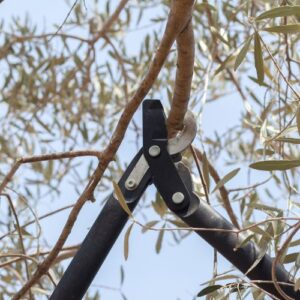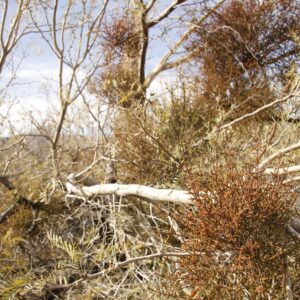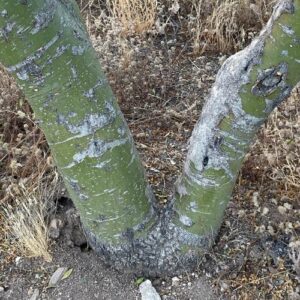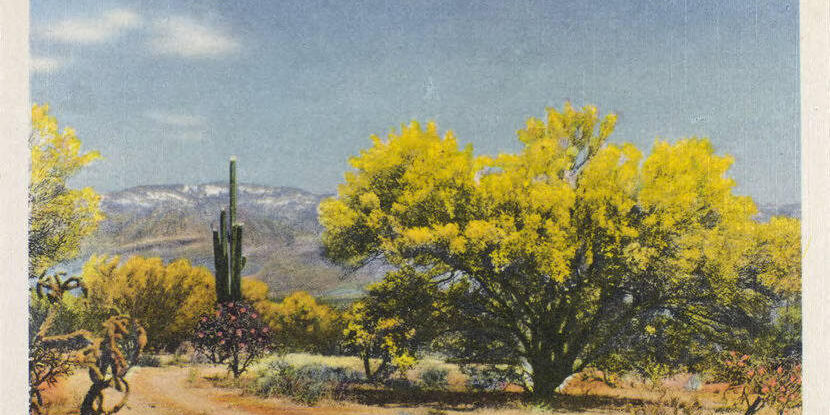
The green-barked palo verde is one of the most prominent trees in the Phoenix area. It’s especially visible in spring when it puts on a beautiful display of bright yellow flowers. But did you know that the palo verde is also Arizona’s official state tree?
Keep reading to find out how and why the palo verde was chosen as the Arizona state tree, the significance of state trees, whether our state tree grows elsewhere, and why the palo verde is unique.
For more information about choosing, planting, and caring for palo verde trees in Arizona, see these articles on our website:
- Best Shade Trees for your Anthem or Greater Phoenix Yard
- Do Palo Verde Trees Make You Sneeze?
- The Best Spring Flowering Teres for the Anthem Area
- Which Palo Verde Tree is Best for your Phoenix-Area Yard?
- Are Palo Verde Borers Killing Your Trees?
- What’s Digging Holes Around my Palo Verde Tree?
When was the palo verde chosen as the Arizona state tree?
In early 1954, several different women from six different Arizona counties introduced the idea of the palo verde as Arizona’s state tree to the Arizona Legislature. The Arizona House of Representatives then introduced and approved House Bill No. 227 (on March 23, 1954) and the Senate approved it on April 3, 1954. The Governor at the time, John Howard Pyle, signed the state tree legislation on April 9, 1954.

The bill didn’t distinguish which palo verde tree would receive this honor, so it is usually assigned to both the foothill palo verde and the blue palo verde (although some places cite only the blue palo verde as the official state tree). You can learn the differences between these two trees in our article about types of palo verdes.
In 1954, palo verde trees were known under the genus Cercidium. They have since been updated to Parkinsonia.
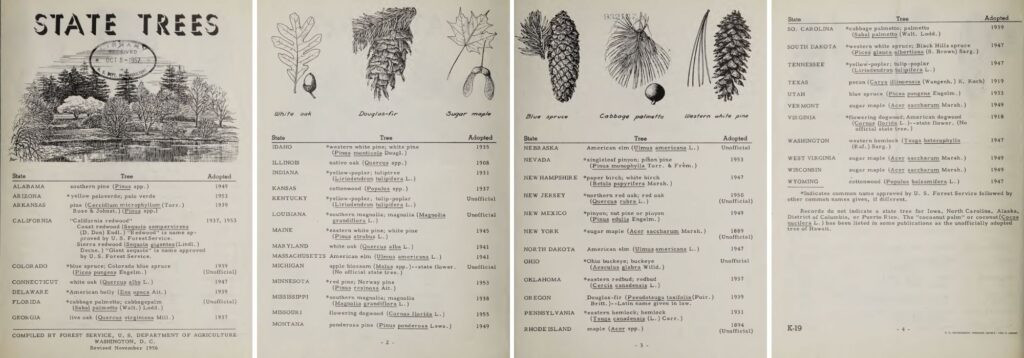
A list of state trees from the U.S. Forest Service in 1956
What is the significance of a state tree?
According to this article, a “national garland of flowers”, with a flower representing each state, was created for the World’s Columbian Exposition in Chicago in 1893. Each state chose a flower that was incorporated into the garland. Soon after that, many states began choosing other “official” items – including trees. As of today, each state (and some U.S. territories) has chosen a tree to represent its unique geographic area.
You can see all of our state trees in this Smokey the Bear poster.
Why was the palo verde chosen as Arizona’s state tree?
Although the exact reason has been lost to history, it’s likely that the palo verde was chosen as Arizona’s state tree because it’s unique to our part of the country. It grows primarily in Phoenix and Tucson where it’s one of the most noticeable trees in the landscape, but not in the more northern areas of the state like Flagstaff. In the northern and higher elevation sections of Arizona, trees like Douglas-fir, ponderosa pine, aspen, fir, and spruce are more prevalent.
In all states except Hawai’i, the state tree is native to that state. It is often chosen for its significance to the area. Unfortunately, not all state’s chosen trees are as numerous as they once were, due to deforestation, tree diseases, and tree pests.
Does Arizona have other “official” items?
Like the other states, Arizona has a state flag, a state seal, and even two Arizona march songs. Other Arizona state items include the:
- Arizona state flower – saguaro cactus blossom
- Arizona state gemstone – turquoise
- Arizona state neckwear – the bola (or bolo) tie!
See other Arizona facts here >>
Are palo verde trees found outside Arizona?
The palo verde tree is native to the Sonoran Desert, including parts of Mexico. However, it is frequently planted in other places with similar growing conditions. For example, it’s a popular yard option in the Palm Springs area, has been spotted in Las Vegas, and recently, the ‘Desert Museum’ variety has been a popular street plant in Los Angeles. You can find palo verde trees growing in countries such as Argentina, Columbia, Peru, Venezuela, or Ecuador.
The similar palo brea tree is native to Mexico and South America, although it grows readily in Southern Arizona.
What makes the palo verde tree unique?
Plants turn sunlight, carbon dioxide, and water into energy through “photosynthesis.” It’s a process that converts light into energy and releases oxygen into the atmosphere.
The green that you see in tree and plant leaves is a pigment called chlorophyll, which is a necessary part of the photosynthesis process. In fact, photosynthesis has been observed not only in leafy plants, but also green algae and even phytoplankton in the oceans.
Palo verdes work so well in the Phoenix area because their green bark allows them to photosynthesize even without their leaves. During periods of drought, palo verde trees will often drop their (small) leaves and instead use their green bark to generate the energy needed to survive. This requires less water and energy and helps the tree survive much longer than trees that rely on their leaves as a source of energy.
In this way, a palo verde tree is similar to a cactus. Cactus plants don’t have leaves, only small spines (which are actually modified leaves). But the body of the cactus is green, and thus that’s where the chlorophyll is and how photosynthesis can still occur.
Will the Arizona state tree work for your property?
If you have room for a tree on your property, a palo verde tree is always a good option. The green bark provides interest year-round, the yellow blossoms in spring are a beautiful sight (and make the bees happy!), and the trees are able to withstand both periods of drought and our windy monsoons – as long as they are well maintained.
Contact us at Titan Tree today if you have any other questions about our state tree!
See Our Latest Articles
More Articles Like This

Titan Tree Care is a full-service tree care company located in Anthem, AZ and serving all of North Phoenix. We offer a wide range of services to meet your tree care needs, including tree and palm trimming, tree pruning, tree removal, stump grinding, and more. We also offer insect or disease treatments and fertilization services. We are dedicated to providing high-quality, safe, and effective tree care services to our customers and work hard to ensure that your trees are healthy and look their best.



